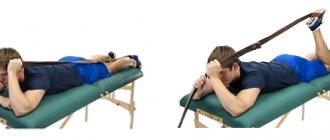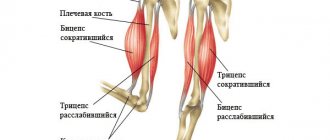Everyone needs physical activity. Moreover, many people dream of losing weight and having a toned body, but they constantly put off training. However, to lose weight, you don't have to immediately go to the gym or pool. You can start small - walking up the stairs correctly. After all, it is in almost every home. Climbing stairs will help you burn extra calories, strengthen your muscles, and reduce your risk of stroke.
Always ready: 5 exercises for training anywhere
What are the benefits of walking up the stairs?
When we walk up or down stairs, we use a whole complex of muscles.
When lifting up, the hip flexors (quadriceps), gluteal muscles, foot muscles, abs and core actively work (they stabilize the body in an upright position). When descending, the muscles of the core, buttocks and calf muscles actively work. Plus, the staircase is your heart’s “best friend.” “Walking up the stairs is useful for the functioning of the cardiovascular system,” explains Daria Tretyakova, exercise therapy specialist and sports rehabilitation specialist at Sportmedica. — This is an aerobic exercise, during which the heartbeat and blood circulation accelerate, and the supply of oxygen to the internal organs improves. During exercise, breathing becomes more frequent. It becomes deeper, which promotes ventilation of the lungs. Stimulates general blood flow and lymph flow.”
Moreover, it is equally useful to go down the stairs and to go up them. “It’s not the direction of movement that plays a role here, but the correct placement of the leg, the transfer of the body and the sharpness of the movement,” adds Daria Tretyakova. But if your goal is to strengthen muscles and reduce weight, lifting is, of course, preferable - this is a more energy-consuming movement. Climbing stairs, a woman weighing 70 kg will spend an average of 10 kcal per minute.
Climbing stairs involves a combined load. “Walking up stairs is a combination of aerobic and anaerobic exercise. The buttocks, thigh and calf muscles are actively involved in the work,” says Sergei Artyushenko, trainer at the ArtFitness fitness club .
With the right approach, you can use the stairs as a “projectile” to strengthen your lower body.
Do stairs help you lose weight?
Training on stairs belongs to such a sports direction as street workout, which also includes street training on uneven bars, horizontal bars and dug-in tires.
The staircase is an excellent cardio exercise machine that combines aerobic and strength (anaerobic) exercise. Walking and running on stairs is more difficult for our body than regular walking and running on a flat surface. The energy consumption for such training is also significantly higher.
In the course of research, it was found that an hour of leisurely climbing the stairs allows you to burn about 500-700 kcal. But if you start running at high speed on the stairs (60 steps per minute), then in just 5 minutes you can burn almost 400 kcal.
Such excellent results in burning calories are ensured due to the fact that when climbing stairs, the heart rate quickly accelerates to 140-160 beats per minute. At the same time, we begin to breathe more often and deeper, thanks to which we capture more oxygen.
Under the influence of increased levels of oxygen in tissues and cells, the oxidation and then burning of fat cells occurs much more efficiently, which accelerates the loss of body fat and weight loss in general.
Thus, walking and running up stairs require more energy from the body than, for example, jogging or football. In addition, sports medicine doctor Frank Ivsto claims that after 3 months of regular training on the stairs, you can increase your lung capacity by 9% and reduce the level of bad cholesterol in your blood by 4%.
In addition to real weight loss, the staircase will help tone your muscles and work out the contours of your body. Climbing stairs trains the upper thigh muscles and gluteal muscles, and if you climb on your toes, you can pump up your calf muscles.
Can walking up the stairs replace a workout?
Not really. “Walking up the stairs can be an excellent alternative to running if impact loads are contraindicated, also for overweight people,” says Sergei Artyushenko. “Stair walking cannot replace a full, balanced workout, but it can be a great way to increase activity.”
If you “forget” about the elevator, the stairs will help you fight a sedentary lifestyle. “I always recommend that clients take the stairs and escalators. This is an excellent way to combat physical inactivity,” says Sergei Artyushenko. — Consider for yourself: a fitness club client trains on average 3-5 hours a week. And in total there are 168 hours in a week. Therefore, increasing your daily activity level is just as important to improving your fitness as regular exercise and eating right. Daily walking on the stairs will help to significantly increase the active part of the basal metabolic rate.”
The load from “stair” fitness is comparable to other types of training. “In terms of efficiency, going up and down stairs is not inferior to jogging and cycling. Therefore, people who want to lose weight and create an ideal figure should definitely include stair walking in their fitness training program. It is to include training in the “diet”, and not replace it with it,” adds Daria Tretyakova.
Contrary to popular belief, such training can also be done by those who have knee problems. “Climbing stairs is a very simple but effective workout that has a healing effect on the knee joint for arthrosis and injuries (meniscus, ligaments). The fact is that when going up the stairs (not going down, but going up!), we actively engage the large muscles of the thigh and lower leg,” notes Daria Tretyakova. — Other positive effects include: improved mobility of joints, ligaments and tendons. During the exercise, all the muscles of the hips and legs work. The volumes in the affected areas are reduced, and over time a beautiful relief is formed. The load falls on: the biceps femoris, large gluteal, calf muscles, and the rectifier of the knee joint.”
Benefits of training on stairs
American doctors Brand Patey and David Herrington conducted an interesting study in which they studied the effect of ordinary stair climbing on the human body and health.
As a result, doctors came to a stunning conclusion: it turns out that if you analyze the results obtained, it turns out that each step a person overcomes prolongs his life by 4 seconds (subject to a generally healthy lifestyle).
That is, if you climb up to the 10th floor on foot, you will be able to “win” an additional 13 minutes of life from your body every day (each floor consists of two flights of an average of 10 steps). Over the years you will get a good increase, which will cost you absolutely nothing, because there are stairs in all multi-storey buildings.
European doctors also conducted research on a similar topic and found that climbing short stairs 3-5 times a day reduces the risk of stroke in men by about 30%.
So if you exercise on the stairs for 10-15 minutes a day, you will be able to prevent the development of a stroke or heart attack in the future. For example, in New York, a stair climbing competition is held annually. For this purpose, the highest staircase in the city is chosen, located in the Empire State Building and numbering 1,500 steps.
Well, you can set your personal records right in your entrance or in any other place where there are stairs.
How to turn climbing stairs into a workout
By regularly climbing stairs, you can somewhat strengthen your leg muscles and improve your endurance. What options for “stair” training are possible? According to Sergei Artyushenko, these are:
Low-intensity cardio. “This is a slow climb up the steps in the target heart rate zone – 50-65% of the maximum,” the expert adds.
The optimal duration of the lesson is 20-30 minutes.
Interval training. “While driving, constantly change the ascent speed,” advises Sergei Artyushenko. “For example, go up two flights at a fast pace, then another at a slow pace.”
Alternate these lifts throughout your 15-minute workout. Do you want to increase the load? Use extra weight. “This could be weights on the legs or a heavy backpack on the shoulders,” recommends Sergei Artyushenko.
How often should you exercise? At least three times a week. And of course, it’s useful to just walk up the stairs more often and without training - this helps fight physical inactivity.
Technique of conducting classes
In order for classes to give the desired effect and lift your spirits, you need to know how to conduct them correctly. The training technique is extremely simple:
- Stand next to the first step, step on it with your right foot, straighten your hip, then it’s your left leg’s turn. Lift it off the floor and move it to a higher step. In this way you need to reach the very end of the span. It is important to walk calmly, just as you do in normal life. This will help distribute the load evenly on both legs.
- During the movement, the back should be straight, the stomach should be pulled in, the body should not deviate, and one should not hold on to the railing. Ideally, you should perform movements with your hands that are typical for race walking.
If you are pursuing the goal of losing weight, you will have to walk up the stairs quite quickly. Only a rapid descent and ascent for half an hour will help you lose excess weight.
Slow movement up the stairs allows you to pump up your buttocks, leg muscles and the whole body. Low walking speed has a positive effect on human organs and systems. If a novice athlete does not have special physical training, then you should not force things and go jogging. Unprepared joints will be subject to high stress and may suffer from it.
Monitoring the size of the load should be done by measuring the pulse. The heart rate should not exceed 150 beats per session. If your heart rate is higher, it is recommended to slow down your pace.
Before you begin, familiarize yourself with the rules of “mindful” walking up the stairs.
The duration, frequency of training and approaches depend on individual characteristics: age, weight, level of training, health status and goal. To establish the norm, consult a coach or sports doctor.
Beginners and overweight people are recommended to start training with 2 approaches “up and down” on the stairs to 2-3 floors, lasting 10-25 tons, without weights. Athletes can increase the load to 6-8 approaches, lasting up to 30-40 tons, using weights.
If shortness of breath occurs, stop and rest for a few minutes. Stop exercising before contacting a specialist if shortness of breath does not go away for a long time or if discomfort appears.
Walking and running up stairs are not the same thing. In this article, we're talking about walking because it's suitable for almost everyone and is a "lighter" option compared to sprinting. Climbing stairs at a fast pace is possible in the absence of the following health problems and under the supervision of a doctor.
While walking up the stairs, remember to breathe evenly and deeply: inhale through your nose, exhale through your mouth. Breathing may be rapid, but the ability to speak must be maintained.
During your training, keep an eye on:
- pulse – frequency should be within 60-80% of MHR,
- posture - do not tilt your body down, your back is straight, your chin is raised,
- position of the legs: angle at the knee when lifting ‒ 90º, resting on the toe. Do not hold onto the railing while climbing.
Start each session with razi - joint gymnastics - and end with stretching. You will not overload the muscles and prepare them for the active part.
Use sportswear and shoes when walking up stairs to avoid discomfort and injury.
If you do not want to conduct classes on the stairs, but want to master a form of fitness, purchase a stepper.
The influence of the stepper on the human body
A stepper is a very popular exercise machine that is used to pump up certain muscles of the body. This device is a good cardio machine that simulates climbing stairs. It is mainly used for the purpose of losing weight, but its benefits are not limited to this:
- the heart and blood vessels are strengthened;
- the respiratory system develops;
- strengthens the muscles of the back, abs, buttocks;
- excess weight is lost;
- figure correction;
- improved coordination;
- stimulation of the metabolic process;
- increasing immunity.
Stepper
There are three types of stepper:
- classic - imitates climbing stairs as accurately as possible;
- balancing - additionally develops coordination of movements and strengthens the abdominal muscles; when moving, the center of gravity of the body shifts in different directions;
- rotating - additionally loads the back, since when walking the body turns. This type with the maximum amount of load and works all the muscles of the body in 10 minutes.
Calorie consumption on a stepper
The number of calories burned depends on the intensity of the exercise. Approximate consumption is 500–600 kcal per hour. With a combination of exercise and proper nutrition, excess weight comes off quickly.
Common mistakes
Walking up the stairs will really help shape your figure and pump up your leg muscles if you do the exercises correctly. Typical errors include the following:
- The man clings to the railing, his body automatically tilts to the side. You should not try to run in this position.
- The pace of training is too fast, which does not allow you to stay “at the distance” during a 20-ton session.
- The athlete moves by jumping, concentrating the weight of the entire body on the toes and forefoot. In this case, the heels almost completely come off the surface of the steps.
- A person tries to talk and breathe at the same time with his mouth open. The best option would be to breathe through your nose, just as you would when running.
Use only comfortable sportswear and sneakers during training. Inappropriate shoes can cause ankle injuries.
A slender figure, strong muscles of the legs and buttocks – isn’t this the dream of every woman? Walking up the stairs and following important recommendations will help you achieve this result:
- Before training, you need to prepare for serious loads and warm up. This will significantly reduce the risk of injury.
- The choice of shoes is of great importance. Be sure to wear sneakers with non-slip, reliable soles.
- If there is a stadium near your home, go there. This is doubly useful, since the training will be done in the fresh air.
- It is not recommended to rest after the ascent; go down straight away, and then you can rest for a couple of minutes before the next ascent.
- After performing one ascent and descent, you will feel your muscles getting tired. A method that works to strengthen them leads to the fact that after the first workout, your legs will hurt for several days.
- In order to increase the load, it is permissible to use special weighting materials. Their weight should not be too heavy so that a half-hour workout can take place without overexertion.
Many experts believe that not a single modern exercise machine can replace walking up the stairs. To lose weight and improve your health, you just need to stop using elevators.
How and when can you put weight on the operated leg?
In the first weeks after the operation, you will have to walk, including stairs, only with crutches. It will be possible to refuse them only with the permission of the doctor, having received it during the next scheduled examination. As a rule, walking with crutches is required for at least 4-12 weeks after hip replacement (depending on the general condition of the patient, recovery rate, type of installed prosthesis, etc.).
Patients who have received a cement endoprosthesis can fully put weight on the operated leg, and from the first days. The only condition for this is the absence of discomfort and pain in the hip joint.
After installing a cementless prosthesis, the affected leg is allowed to be loaded only with its own weight. And it makes up on average ¼ or 1/3 of the total mass of the entire body. For example, if a person weighs 60 kg, then the operated limb can be loaded with no more than 15-20 kg. It’s best to ask your doctor about all this in more detail so that he can show you everything and explain the incomprehensible nuances.
Who is contraindicated for running on stairs?
Such a simple-looking workout should be approached with great attention and take into account that it is suitable for everyone. If you suffer from varicose veins, hypertension, scoliosis or diseases of the cardiovascular system, then such activities are contraindicated for you.
Those who have suffered injuries to the knees, ankles and hip joints, or have a high body mass index (above 30) should not run stairs. Even if you are confident in your health, consulting a doctor will not hurt.
Of course, if your entrance is completely smoky or full of odors from the garbage disposal, then you should look for other places for training - maybe in the entrance of a neighboring house or on the street.
How to organize training
There are no uniform rules for walking up stairs. Each person must select the load individually, taking into account age, health status and the goal being pursued.
There are two main postulates that must be adhered to, guided, in the future, by the results achieved.
- Start small: the duration of the first workouts does not exceed 5 minutes, this means climbing the stairs to a height of 2-3 floors and descending. Gradually the load increases, reaching 20 minutes or more.
- Running or walking – the one who exercises chooses. Training should not cause discomfort. Shortness of breath indicates that the pace taken initially was too high. It is necessary to moderate the rhythm and reduce the load to a comfortable level. It is very important to monitor your breathing.
Cardio workout: how many calories does it burn?
How many calories are burned when squatting?
You should know how many calories a cardio workout burns with a weight of 60 kg in 30 minutes:
- step aerobics - 295 kcal;
- exercise bike - 208 kcal;
- swimming - 247 kcal;
- walking 6 km per hour - 152 kcal;
- running 10 km per hour - 249 kcal.
Swimming underwater
Types of Cardio Training
There are many sports for cardio training that have different effects on a person, and burning 500 kcal in 45 minutes of cardio training is quite possible. It is only necessary to load the body gradually in order to adapt it to new loads.
How many calories are burned when swimming?
Cardio is beneficial for the heart. Such training develops the cardiovascular and respiratory systems.
Note! Properly selected cardio load and intensity of exercise increases physical capabilities without harming the muscles.
Running is the simplest physical activity, but it is not suitable for everyone. It is necessary to take this sport seriously if you are overweight, have problem joints or have poor physical fitness. Running strengthens the legs, buttocks, abdominal muscles and intercostal muscles. During a jogging walk, your arms work, which contributes to the load on the biceps, triceps and broad back muscles.
Cycling will be an excellent exercise if you have poor physical fitness and are overweight. While riding, the main load goes to the quadriceps. The gluteal muscles, calf muscles and thighs do not remain unloaded.
Swimming is great for people who are overweight and have problem joints.
Swimming strengthens:
- muscles of the legs, arms, back, abs;
- joints and ligaments;
- increases endurance;
- has a positive effect on the respiratory system.
During swimming (crawl, breaststroke), oxygen is retained when inhaling, and exhalation occurs under water, in a dense environment. This workout increases lung capacity, which promotes deep breathing and good oxygen saturation.
Aerobics is the best form of cardio exercise for those who find it boring to workout alone at home. Aerobics includes: jumping, stretching, active walking and floor exercises.
Boxing guarantees a good cardio load. To avoid bruises, you can only exercise with a bag. By practicing punches, you can not only learn self-defense, but also have a positive effect on the heart.
Thus, cardio training helps you burn 500 calories in 45 minutes quite effectively.
Burning calories during physical activity
Regardless of gender or age, the human body must receive the required portion of calories every day. The daily intake is individual for everyone and depends on physical activity. Young people are more active, while middle-aged people lead a more relaxed lifestyle. Also, a person with a sedentary job needs fewer calories, unlike an athlete.
Counting calories is the first step to losing excess weight. Knowing your individual daily requirement, you can calculate the required number of calories per day to start losing weight. You can calculate using a formula or a special online calculator.
The female body needs fewer calories than the male body. This is due to genetics. A woman needs about 2000 kcal per day. If you need to lose weight, subtract 10–20% (500 kcal) from your normal daily intake.
Men have a fast metabolism and tend to lose weight. The daily norm is about 2400 kcal. To lose weight, men and women need to consume 10-20% fewer calories.
Calorie table
Harm
If you do not follow the recommendations and walk up the stairs carelessly, you can get serious health problems:
- Heartache . This may happen due to the fact that the organ was not ready for such heavy loads. If unpleasant sensations arise, you need to reduce the load (walk at a calm pace) or stop the activity altogether. Next time you should start your workout with a measured step, and if symptoms appear again, it is better to first visit a doctor and find out if you can exercise.
- Pain in muscles and joints . The reason for the appearance is the same as for pain in the heart. Usually, unpleasant sensations occur the next day after training - you need to wait until they pass (usually 1-3 days) and start walking up the stairs again, but this time reducing the load.
- With serious heart problems, any physical activity can only aggravate the pathology and even cause death . Therefore, if you have cardiovascular diseases, you should definitely consult a cardiologist.
- Injury . The easiest thing you can get is a dislocation of the ankle joint, which occurs as a result of wearing uncomfortable shoes or improper walking technique. If you walk on stairs carelessly, you can fall and suffer fractures and serious head injuries.
Adviсe
- Before you start training, you need to warm up and warm up your muscles to avoid injury and damage.
- Shoes for training should be durable and comfortable, with practical non-slip soles.
- Outdoor activities will bring double benefits.
- It is not recommended to rest between ascent and descent.
- For pregnant women and older people, the recommendation is to hold on to the railing to avoid tripping and falling.
- After the first serious workout, your legs ache for a couple of days; this is a normal reaction of the body.
- For men and those who want to lose weight (regardless of gender), walking with weights is recommended.
If you experience knee pain while walking that does not go away even after you stop exercising, you should consult a doctor and postpone training. The situation is similar with a crunch in the knees: a physiological crunch is not dangerous, but you need to make sure that this is not a pathology











